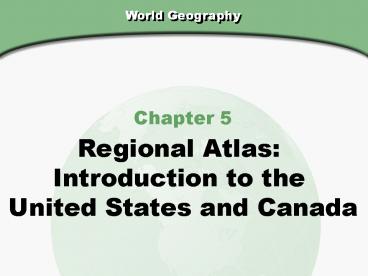World History Lecture Notes - PowerPoint PPT Presentation
1 / 13
Title:
World History Lecture Notes
Description:
World Geography Chapter 5 Regional Atlas: Introduction to the United States and Canada Historical Overview Spanish, French, and English settlers founded colonies in ... – PowerPoint PPT presentation
Number of Views:372
Avg rating:3.0/5.0
Title: World History Lecture Notes
1
World Geography
Chapter 5
Regional Atlas Introduction to the United
States and Canada
2
World Geography
Chapter 5 Regional Atlas Introduction to the
United States and Canada
Section 1 Historic Overview
Section 2 Physical Characteristics
Section 3 Climates
Section 4 Ecosystems
Section 5 People and Cultures
Section 6 Economics, Technology, and Environment
Section 7 Database
3
Historical Overview
1
By the early 1500s, Native Americans were joined
by Europeans and Africans as inhabitants of North
America.
- Spanish, French, and English settlers founded
colonies in North America. - French Quebec came under British rule, and the
British colonies gained independence as Canada
and the United States of America. - Both Canada and the United States expanded
westward through annexation, wars, and treaties
in the 1800s. - Regional differences led to civil war in the
United States. - The new technology of the Industrial Revolution
fueled economic growth. - The United States and Canada assumed roles of
world leadership in the 1900s, and common
interests forged close ties between the two
countries.
4
Physical Characteristics
2
5
Physical Characteristics
2
- Canada and the United States share a number of
physical characteristics - High mountains in the west that form the
continental divide - Plains in the central area
- Lower mountains in the east
6
Climates
3
7
Climate
3
Latitude, elevation, and distance from the oceans
affect the climates of the United States and
Canada.
- Tropical wet--covers southeast region of United
States - Humid continental--surrounds the area of the
Great Lakes - Sub arctic--stretches across northern North
America (Canada and Alaska) from the Atlantic to
the Pacific - Western parts of North America are comprised of
many climates such as Highlands, Semiarid, Marine
west coast, and Mediterranean.
8
Ecosystems
4
9
Ecosystems
4
The variety of ecosystems found in the United
States and Canada includes arctic tundra,
forests, grasslands, and desert scrub.
- Temperate grasslands exists in the central plains
region. - Desert scrub and chaparral cover parts of the
southwest and west of the United States. - Coniferous, deciduous, and mixed forests cover
much of North America. - Tundra stretches across parts of Alaska and
northern Canada.
10
People and Cultures
5
While the population of the United States is much
larger than Canadas, there are many similarities.
- Both countries emerged from large English
colonies. - Both countries have become home to large numbers
of immigrants. - While most people now live in urban, not rural,
areas, both countries have seen a rise in their
suburban populations. - The populations of both countries have long life
expectancies. - The educational systems of both countries
contribute to high rates of literacy.
11
Economies, Technology, and Environment
6
12
Economies, Technology, and Environment
6
Both the United States and Canada have a wide
variety of resources and economic activities.
- The people of both countries enjoy a high
standard of living. - Manufacturing and trade are important to large
parts of both countries. - Commercial farming and livestock raising are also
very important.
13
Database
7
- Canada and the United States are two of the
worlds largest energy producers and consumers. - While the United States relies on mostly fossil
fuels, Canadas main source of power is
hydroelectricity. - Although total electricity consumption is higher
in the United States, Canada uses more
electricity per capita, or per person. - Since 1969, Canada has exported more energy than
it has imported. - The United States purchases more than 90 percent
of the energy Canada sells.































